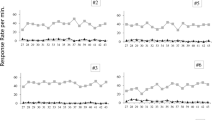Abstract
Second-order conditioned suppression of keypecking was demonstrated in pigeons by pairing a tone (CS2) and an on-key stimulus (CS1) after the on-key stimulus had been paired with electric shock (US). Suppression of keypecking during CS2 was significantly greater for subjects in this group than for subjects in control groups that received either (a) pairings of CS1 and US but “truly random” presentations of CS2 and CS1 or (b) pairings of CS2 and CS1 but “truly random” presentations of CS1 and US.
Similar content being viewed by others
References
AYRES, J. J. B., & QUINSEY, V. L. 1970. Between-groups incentive effects on conditioned suppression. Bulletin of the Psychonomic Society, 21, 294–296.
AYRES, J. J. B., BENEDICT, J. O., & WITCHER, E. S. 1975. Systematic manipulation of individual events in a truly random control in rats. Journal of Comparative and Physiological Psychology, 88, 97–103.
AZRIN, N. H. 1959. A technique for delivering shock to pigeons. Journal of the Experimental Analysis of Behavior, 2, 161–163.
BENEDICT, J. O., & AYRES, J. J. B. 1972. Factors affecting conditioning in the truly random control procedure in the rat. Journal of Comparative and Physiological Psychology-, 78, 323–330.
DAVIS, H., & McINTLRE, R. W. 1969. Conditioned suppression under positive, negative, and no contingency between conditioned and unconditioned stimuli. Journal of the Experimental Analysis of Behavior, 12, 633–640.
HERENDEEN, D., & ANDERSON, D. C. 1968. Dual effects of a second-order conditioned stimulus: Excitation and inhibition. Psychonomic Science, 13, 15–16.
HITTESDORF, W. M., & RICHARDS, R. W. 1975. The absence of time-out responding by pigeons during shock-correlated stimuli. Bulletin of the Psychonomic Society, 5, 9–12.
KAMIL, A. C. 1968. The second-order conditioning of fear in rats. Psychonomic Science, 10, 99–100.
KELLER, R. J., AYRES, J. J. B., & MAHONEY, W. J. 1977. Brief versus extended exposure to truly random control procedures. Journal of Experimental Psychology: Animal Behavior Processes, 3, 53–65.
KREMER, E. F. 1971. Truly random and traditional control procedures in Cer conditioning in the rat. Journal of Comparative and Physiological Psychology, 76, 441–448.
KREMER, E. F. 1974. The truly random control procedure: Conditioning to the static cues. Journal of Comparative and Physiological Psychology, 86, 700–707.
KREMER, E. F., & KAMIN, L. J. 1971. The truly random control procedure: Associative or nonassociative effects in rats. Journal of Comparative and Physiological Psychology, 74, 203–210.
MACKINTOSH, N. J. 1973. Stimulus selection: Learning to ignore stimuli that predict no change in reinforcement. In R. A. Hinde & J. T. Stevenson-Hinde (Eds.), Constraints on learning. New York: Academic Press.
MACKINTOSH, N. J. 1975. A theory of attention: Variations in the associability of stimuli with reinforcement. Psychological Review, 82, 276–298.
PAVLOV, I. P. 1927. Conditioned reflexes (trans, by G. V. Anrep). London: Oxford University Press.
PROKASY, W. F. 1965. Classical eyelid conditioning: Experimental operations, task demands, and response shaping. In W. F. Prokasy (Ed.), Classical conditioning: A symposium. New York: Appleton-Century-Crofts.
QUINSEY, V. L. 1971. Conditioned suppression with no Cs-Ucs contingency in the rat. Canadian Journal of Psychology, 25, 69–82.
RASHOTTE, M. E., GRIFFIN, R. W., & SISK, C. L. 1977. Second-order conditioning of the pigeon’s keypeck. Animal Learning and Behavior, 5, 25–38.
RESCORLA, R. A. 1966. Predictability and number of pairings in Pavlovian fear conditioning. Psychonomic Science, 4, 383–384.
RESCORLA, R. A. 1967. Pavlovian conditioning and its proper control procedures. Psychological Review, 75, 71–80.
RESCORLA, R. A. 1968. Probability of shock in the presence and absence of Cs in fear conditioning. Journal of Comparative and Physiological Psychology, 66, 1–5.
RESCORLA, R. A. 1969. Conditioned inhibition of fear resulting from negative Cs-Us contingencies. Journal of Comparative and Physiological Psychology, 67, 504–509.
RESCORLA, R. A. 1973. Second-order conditioning: Implications for theories of learning. In F. J. McGuigan & D. B. Lumsden (Eds.), Contemporary approaches to conditioning and learning. Washington, D.C.: V. H. Winston.
RESCORLA, R. A. 1977. Pavlovian second-order conditioning: Some implications for instrumental behavior. In H. Davis & H. M. B. Hurwitz (Eds.), Operant-Pavlovian interactions. Hillsdale, N.J.: Erlbaum.
RESCORLA, R. A., & FURROW, D. R. 1977. Stimulus similarity as determinant of Pavlovian conditioning. Journal of Experimental Psychology: Animal Behavior Processes, 3, 203–215.
RESCORLA, R. A., & WAGNER, A. R. 1972. A theory of Pavlovian conditioning: Variations in the effectiveness of reinforcement and nonreinforcement. In A. H. Black & W. F. Prokasy (Eds.), Classical conditioning II: Current theory and research. New York: Appleton-Century-Crofts.
RIZLEY, R. C., & RESCORLA, R. A. 1972. Associations in second-order conditioning and sensory preconditioning. Journal of Comparative and Physiological Psychology, 81, 1–11.
SELIGMAN, M. E. P. 1968. Chronic fear produced by unpredictable electric shock. Journal of Comparative and Physiological Psychology, 66, 402–411.
WASSERMAN, E. A., DEICH, J. D., HUNTER, N. B., & NAGAMATSU, L. S. 1977. Analyzing the random control procedure: Effects of paired and unpaired Css and Uss on autoshaping the chick’s keypeck with heat reinforcement. Learning and Motivation, 8, 467–487.
Author information
Authors and Affiliations
Additional information
This research was supported in part by a BRSG grant (NIH) to Colorado State University. The authors would like to thank the Graduate School at Colorado State University for additional financial support. This experiment, which was conducted by the first author under the supervision of the second author, represents a thesis submitted as partial fulfillment of requirements for an M.S. degree at Colorado State University. The results of this research were presented at the 1978 convention of the Rocky Mountain Psychological Association in Denver, Colorado.
Rights and permissions
About this article
Cite this article
Hittesdorf, W.M., Richards, R.W. Aversive Second-Order Conditioning in the Pigeon. Psychol Rec 28, 605–613 (1978). https://doi.org/10.1007/BF03394578
Published:
Issue Date:
DOI: https://doi.org/10.1007/BF03394578




